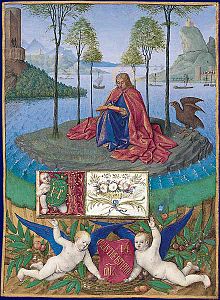|
Hours of Étienne Chevalier The Hours of Étienne Chevalier is an illuminated book of hours commissioned by Étienne Chevalier, treasurer to king Charles VII of France, from the miniature painter and illuminator Jean Fouquet. Only 48 of its leaves with 47 miniatures survive, dispersed across seven collections in Europe and the United States of America, of which 40 illuminations are held at the Musée Condé in Château de Chantilly in France. HistoryIt was probably commissioned by Chevalier for his personal use around 1452, just after he was made treasurer of France by Charles VII of France and just after the death of his wife, who does not appear in any of the illuminations with him. He was definitely the commissioner of the work, since his portrait appears frequently in it, as do his full name "Maistre Estienne Chevalier" (notably in the border of the image of The Presentation of the Virgin) and his cypher "EE" in several of the miniatures. It was probably completed around 1460 – François Avril and Nicole Reynaud state that for most of the 1450s Fouquet spent almost all his time on this and another commission from Chevalier, the Melun Diptych.[1] The manuscript was owned by Chevalier's descendants until the 17th century and by his last direct descendant, Nicolas Chevalier (1562–1630). The scholar François Roger de Gaignières indicates that it appeared intact at the end of the 17th century and so it was probably divided over the course of the 18th century, with each miniature cut out to turn them into separate artworks and their textual parts obscured.[2] Of the best-preserved miniatures, 40 were mounted on wooden panels by a Parisian frame-maker at the end of the 18th century. During the French Revolution, these 40 miniatures were bought by an art-dealer from Basel who sold them in 1809 to the German banker Georges Brentano. His son Louis sold them on to Prince Henri, Duke of Aumale in 1891 for 250,000 francs. Prince Henry then exhibited them at his château de Chantilly in its Santuario, where they can still be seen.[3] One miniature of David at Prayer is recorded in 1831 in the collection of the English poet Samuel Rogers, close to 40 other miniatures – these passed to the British Museum in 1886. In 1881, another miniature (of Saint Anne and the three Maries) was bought by the bibliothèque nationale de France. In 1889, comte Paul Durrieu, curator of paintings at the musée du Louvre, oversaw the purchase of a miniature of Saint Martin, and in the Louvre's drawings collection discovered another, of Saint Margaret, which had been presented to the Louvre in 1856. In 1922 he discovered yet another in the collections of Upton House, Warwickshire (National Trust), showing St Michael fighting the Dragon. In 1946, two more leaves resurfaced in a sale at Sotheby's. These showed The Hand of God protecting the Faithful and A Miracle of Saint Vrain. The first of these was acquired by the banker Robert Lehman, who donated it to the Metropolitan Museum of Art in New York in 1975, whilst the latter was bought by Georges Wildenstein, whose son donated it to the Musée Marmottan-Monet in 1971 along with a collection of other miniatures cut from manuscripts, which has been on show there since 1981.[4] That same year, a double page or bifolium of text from the manuscript was rediscovered in a private collection.[5] CompositionOrganisationFor a long time the book's composition was only known from the 40 illuminations in the musée Condé, which only gave a succession of scenes from the life of Christ followed by episodes from saints' lives or from the Golden Legend. Yet, like any book of hours, it would originally have featured the three offices from the Liturgy of the Hours – the Office of the Virgin, the Office of the Passion and the Office of the Holy Spirit. Also, the book's composition was novel and complex, since each of the three offices was interlaced with some from the other two, making it difficult to determine the order of the illuminations. A certain number of illustrations can also be determined as missing after this order's establishment. The original manuscript probably included an illustration of Saint Luke, of the prayer Obsecro te, of prime and of Sext of the Office of the Holy Spirit, of sext in the Office of the Passion, along with several pleas or prayers to saints such as Lawrence, Christopher or Sebastian.[5] Surviving foliosIn the order determined by Nicole Reynaud (2006), the surviving folios are as follows (with the collection being the musée Condé at Chantilly unless otherwise noted):
References
Bibliography
External linksWikimedia Commons has media related to Hours of Étienne Chevalier. |
Portal di Ensiklopedia Dunia